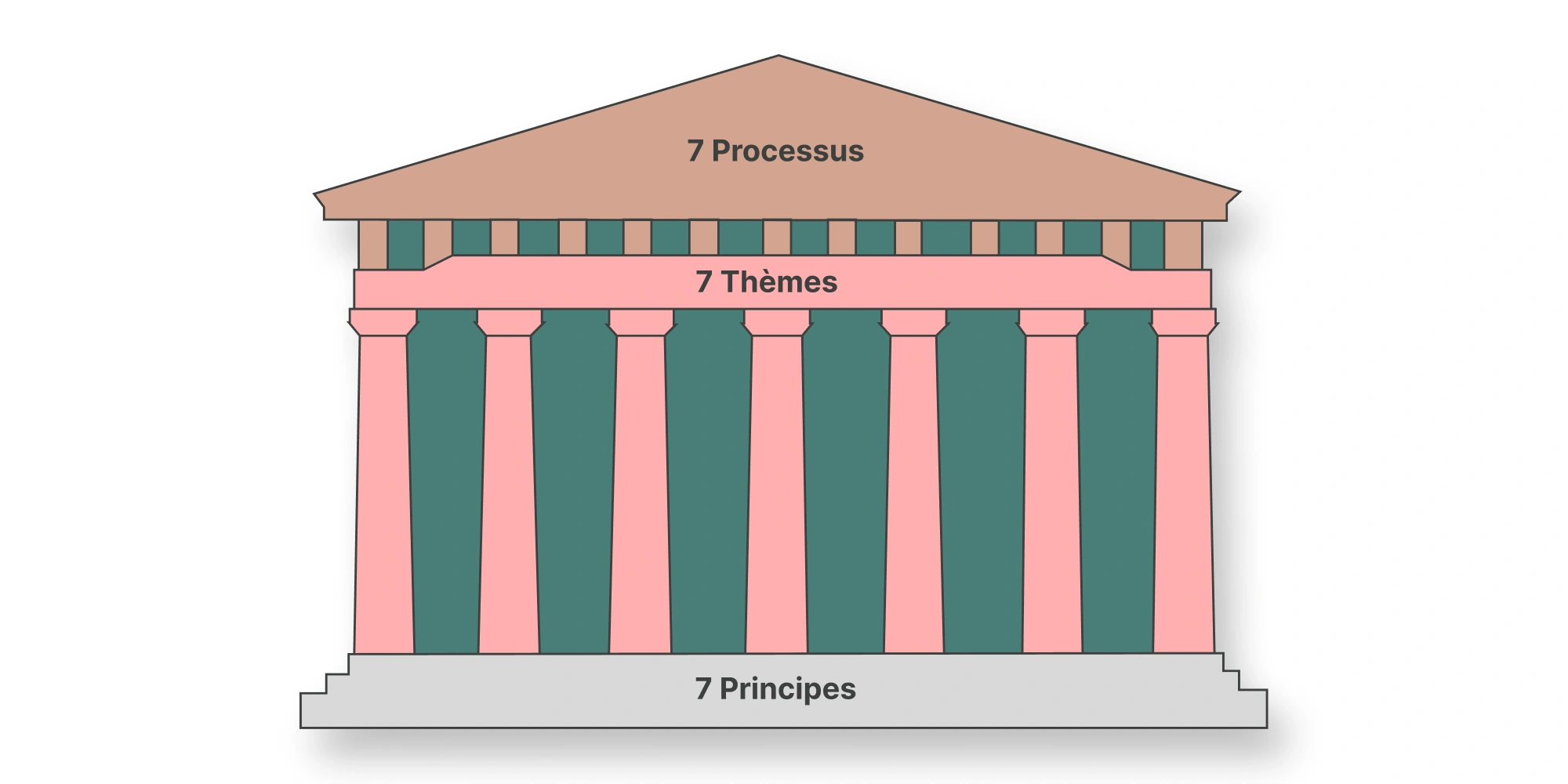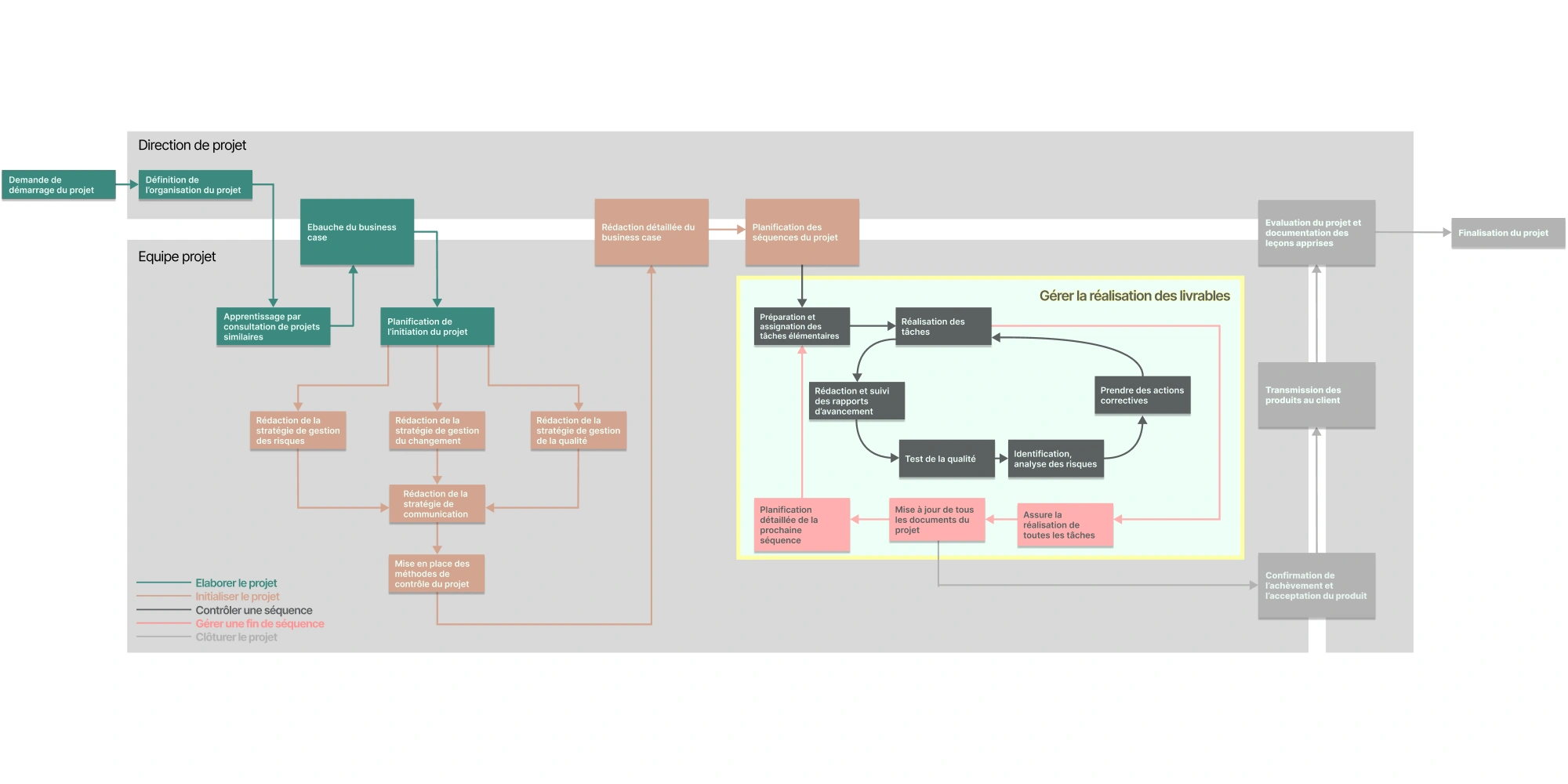PRINCE2: a universal, structured method that adapts to any project
Estimated reading time : 14 minAs projects grew more complex and diverse, it became necessary to create a universal, structured method capable of managing any type of project, beyond technical or IT domains.
This led to a methodology first called PROMPT in 1979, renamed PRINCE in 1989, then improved to become PRINCE2 in 1996. PRINCE2 (PRojects IN Controlled Environments) is a structured project management and certification method focused on three essentials: organization, management, and control.
The method was developed by a team of specialists with input from a review committee of 150 public and private organizations.
The PRINCE2 method provides a highly operational framework for managing projects effectively. It presents 7 processes, each giving specific attention to the 7 themes, all grounded in the 7 principles of PRINCE2.

The 7 PRINCE2 principles
1. Continued business justification: the project must have a clear reason to start and to continue.
2. Defined roles and responsibilities: everyone must know their role and accountabilities.
3. Focus on products: the goal is to deliver products that meet stakeholder needs.
4. Learn from experience: leverage lessons from past projects and embed good practices.
5. Manage by exception: teams operate autonomously within agreed tolerances.
6. Manage by stages: break the project into smaller, manageable parts.
7. Tailor to suit the project: adapt the method to the environment and needs.
The 7 PRINCE2 themes
Themes describe the project management domains derived from the 7 principles and are applied continuously throughout the method.
Business case management
Write, monitor, and maintain the business case throughout the project’s life. The business case determines whether the project is desirable, viable, and achievable. It includes:
- Options to deliver the project, including a “Do nothing” baseline scenario
- Expected benefits and how to measure them
- Dis-benefits (outcomes perceived negatively by some stakeholders)
- Project start and end points
- Costs to deliver and maintain the solution
- Calculation of the return on investment
- A risk analysis for the project
- Objectives and the problem or opportunity being addressed
Change control
Since projects face events and evolving needs, help identify, assess, and control potential changes to what has been baselined. The project manager should:
- Define a strategy upfront for handling change requests
- Determine and baseline initial data for project items
- Maintain a central register of all change requests
- Document each change from origin to implementation
- Keep stakeholders informed throughout
Organization
Define and establish roles and responsibilities—identify the project’s “Who.” PRINCE2 recommends:
- Teams with representatives of the business, customer, users, and suppliers
- Clear, defined responsibilities for directing, managing, and delivering the project
- Regular reviews with all stakeholders
- An effective communication strategy
Plans
Provide a framework to design, develop, and maintain project plans. Maintain and communicate the following:
- Project plan (roadmap): high-level targets for time, cost, scope, and quality
- Stage plan (execution plan): like the project plan but far more detailed; used daily by the PM
- Hierarchical plan: decomposition into objectives, deliverables, tasks, subtasks, and work packages
- Task flow plan: considers durations and interdependencies between tasks
Progress control
Define how to monitor and compare achievements, provide forecasts, and control variances. To do so:
- Teams regularly report status of completed work
- The project manager monitors progress against plans and forecasts
Quality management
Ensure the product meets expectations and will be used as intended. To achieve this:
- Stakeholders agree on product quality and acceptance criteria
- Define and document baselines and tolerances for each deliverable
- Establish evaluation methods to measure and control criteria throughout the project
Risk management
Set an approach to identify, assess, and control uncertainties throughout the project. This involves:
- Understanding the project context
- Identifying with stakeholders the uncertain elements affecting time, cost, quality, scope—positively or negatively
- Estimating probability and impact for each uncertainty and evaluating overall risk
- Planning and implementing responses: avoid, reduce, prevent, transfer, accept, exploit, or share
- Communicating so everyone is aware of threats and opportunities
The 7 PRINCE2 processes
Processes are structured sets of activities and phases, designed to be flexible and adaptable to any project type while ensuring each theme is properly addressed.
1. Directing a Project: can be triggered at any stage; senior management supports teams by gathering information, approving, and/or making decisions
2. Starting Up a Project: sequence — Project mandate → Define project organization → Learn from similar projects → Outline business case → Plan the Initiating a Project process
3. Initiating a Project: sequence — Define communication strategy → Define change control strategy → Set up risk management → Define product quality and acceptance criteria and evaluation methods → Write the detailed business case → Plan project stages in detail
4. Controlling a Stage: sequence — Prepare and assign work packages → Regular progress reporting → Track and identify uncertainties → Assess achievements → Take corrective actions if needed
5. Managing Product Delivery: triggered for each deliverable to record progress and perform quality checks
6. Managing a Stage Boundary: at each stage end, ensure all work packages are complete, update project documents (business case, risk register, roadmap), and prepare the next stage plan
7. Closing a Project: sequence — Confirm completion and acceptance → Handover to the customer → Evaluate the project (planned vs actual) → Close the project

PRINCE2: benefits and limitations
In short, PRINCE2 is a project management methodology renowned for its rigorous structure and clear framework. It improves governance with precise monitoring and clearly assigned responsibilities. While it requires discipline and thorough documentation, it provides a solid foundation to deliver projects:
- Clear structure: projects are split into phases with defined processes, ensuring methodical, organized delivery.
- Risk control: PRINCE2 embeds strong risk and change tracking, limiting surprises and improving anticipation.
- Adaptability: the method can be tailored to project size and complexity, offering flexibility.
- Stakeholder engagement: involving business, suppliers, customers, and sustained communication fosters strong relationships.
However, PRINCE2 comes with constraints:
- It relies on substantial documentation, which can slow decision-making.
- Its formal approach may be seen as rigid and complex.
- Implementation requires time and specific skills, potentially adding training and certification costs.
PRINCE2 is particularly well-suited to complex, structured projects requiring a clear methodological framework and optimized risk management. It fits organizations seeking a rigorous, methodical approach.
It combines the rigor of formal management with the adaptability needed to ensure success in a controlled environment.
Discover other project management methods
Orchesia: another way to apply rigor
With Orchesia, there’s no need for deep training or PRINCE2 certification. Thanks to our innovative methods, combine the rigor of best practices with the simplicity of an intuitive tool.
Organize, plan, and track progress while reducing risks and fostering real-time collaboration. Direct, start up, initiate, control, deliver, and close your projects with confidence.
Try our project management software Orchesia free for two weeks, no commitment!